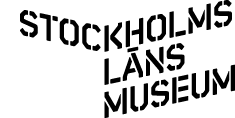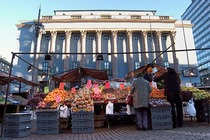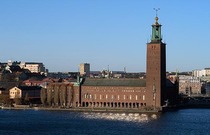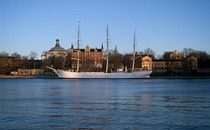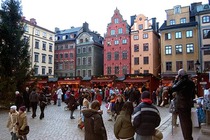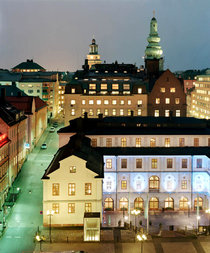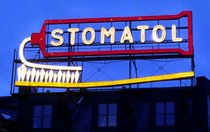Stockholm
Stockholm was founded during the 1250s and rapidly became the most important town in Sweden, and eventually its capital. Gamla stan (The Old Town) is characterised by mediaeval lanes, 17th century buildings and the Stockholm Palace from the 18th century. Buildings from the late 19th century and early 20th century dominate the ridges of central Stockholm (in Swedish: “malmarna”).
Stockholm is mentioned for the first time in a letter dated 1252 from the king’s right-hand man, Birger Jarl, who is considered to be the founder of the town. Growth was rapid, and Stockholm had become the largest town in the country by the end of the 13th century. The royal estate promoted this growth, seeing the strategic advantages of the town’s location, centrally placed as it was in the kingdom (which, it must be remembered, at that time included Finland). As a consequence, the Stockholm Palace was reinforced to become the strongest defence construction in the country, being essentially impregnable. Mediaeval Stockholm was one of the few towns in Sweden with a town wall. And during the late Middle Ages, trade through Stockholm was dominated by the export of copper and iron from Bergslagen.
Stockholm as capitalIt was not until the 17th century that Stockholm became capital of Sweden, in the sense of being the administrative centre of the country. Until then, the king and court lived nomadically, moving between a number of royal estates and castles in the most important parts of the country. Stockholm was one of these, and became the principal location for royal power. Initially, there was a profound German influence on the town. Many wealthy German merchants set themselves up in Stockholm, and soon came to play dominant roles in the various councils that controlled the town. However, their political influence diminished during the 15th century, and they adopted more and more Swedish ways. Stockholm had a population of between 6,000 and 7,000 by the end of the mediaeval period. The houses were mainly built from stone or brick, in contrast with other Swedish towns (with the exception of Visby).
Through the deliberate concentration of both power and trade that Swedish kings exercised, Stockholm came to undergo a major transformation during the 17th century. The Stockholm Palace was extended, and a new town plan with a modern grid structure was established following a major fire in 1625. Many imposing palaces for the nobility were erected, and the town grew rapidly onto the ridges around Stadsholmen (which today is the Old Town). Growth to a major city
The industrialisation of Sweden during the 19th century led to a rapid growth in population and large-scale movement of people from the countryside into the towns, including Stockholm. From a population of just under 100,000 around the middle of the 19th century, Stockholm grew to a population of over 300,000 at the turn of the century (1900). The rapid growth initially led to serious social problems including crowded living, disease, and a poverty that was often more dire for the newly arrived inhabitants than it had been when they lived in rural areas. Large parts of the town lacked paved streets, clean water and sewage facilities, and the sanitary conditions were very poor.
The expansion of the town onto the surrounding ridges was controlled by what was known as the “Lindhagen Plan” and by the national building regulations laid down in 1874. The intention was to replace the many unhealthy and cramped areas with open and airy parks with broad avenues. Buildings were to consist of tall blocks, enabling poorer folk to remain living on the ridges. Thus, an explosive expansion of the city could start, and nearly 2,000 buildings were erected on the ridges during the 1880s.
Notable buildings in StockholmA number of monumental buildings were erected in Stockholm during the first decades of the 20th century including the Riksdag building, Stockholm City Hall, The Royal Swedish Opera, the Stockholm Court House, the Stockholm Public Library, the Stockholm Concert Hall, and Kungstornen. These buildings today are major features in the special character of the city of Stockholm.
The centre of Stockholm has undergone dramatic changes since the 1960s. A clearance programme was carried out in the centre of the city in the early 1960s, and much of the stone-based town from the 19th century was demolished to make way for the modern city we see today with the Hötorget buildings, Sergels Torg, “plattan” – an open plaza under the water fountains of Sergels Torg, and Kulturhuset. All of these have become well-known symbols of modern Stockholm. At the same time, much of central Stockholm was given over to office buildings, which created an environment that was deserted at the end of the working day. However, in recent decades the social and cultural life of the city has acquired an international stamp, with a great expansion in the number of leisure facilities and restaurants.
Links
Stockholm Visitors Board
Stockholm City Museum
